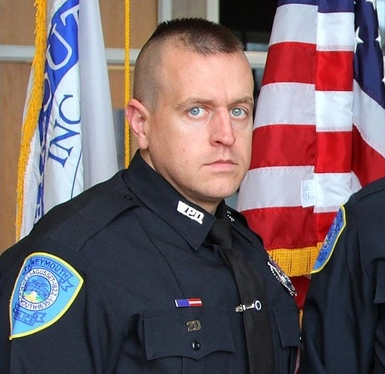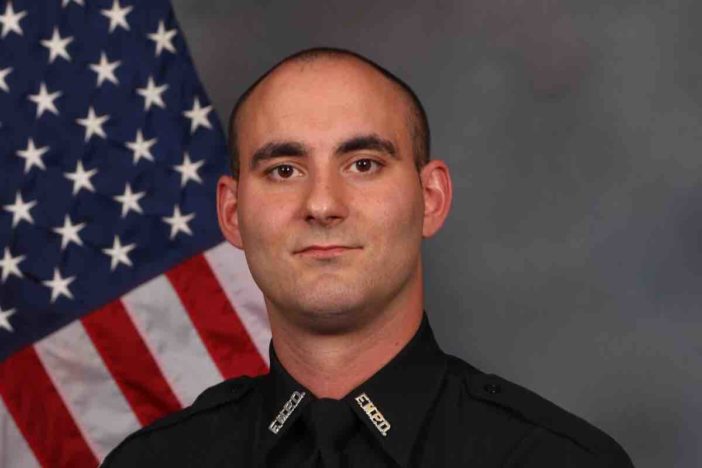Today, Fort Meyers Police Officer Adam Jobbers-Miller was laid to rest during a funeral attended by thousands of fellow police officers, family and community members. He was the third officer to be killed by an “unarmed” suspect in the past month.
On July 21, 2018, Jobbers-Miller and another officer responded to a call of a stolen cell phone at a gas station. After getting preliminary information, they located the suspect walking down a nearby street. According to news reports, the suspect lay face down on the ground and said, “Don’t shoot me, don’t shoot me. Shoot me in the back. Four, three, two, one. Shoot me. I don’t want to stand up. Shoot me while I’m not looking.”
The officers attempted to deescalate the encounter and asked the suspect to stand up, saying they had no reason to shoot him. The suspect took off running with the officers in pursuit. Jobbers-Miller caught up to the man, at which point the suspect turned with his arms down and palms up. Then, suddenly, he attacked the officer, knocking him to the ground.
Tragically, the man was able to overpower the officer, take his weapon, and shoot him. Another shooting occurred, during which the suspect was wounded and taken into custody.
Jobbers-Miller was transported to the hospital, where on July 28, 2018, he succumbed to his injuries. He had been a police officer for three years and was engaged to be married.
The suspect who shot and killed Jobbers-Miller was unarmed.
As the State of California debates changing the threshold for officer use of deadly force, I wonder how many legislators would have considered the fatal shooting of the unarmed suspect in this tragedy as a “necessary” use of force.
If Jobbers-Miller had shot the unarmed suspect while he was on the ground facing a person intent on doing him harm, would he have met the standard of “necessary”?

On July 15, 2018, Sergeant Michael Chesna was shot and killed while investigating a call of an erratic driver. The unarmed suspect was able to disable him with a rock, then take his service weapon and shoot him several times. Photo from the Officer Down Memorial Page
On July 15, 2018, Weymouth, MA Police Sergeant Michael Chesna was shot and killed after responding to reports of an erratic driver. The suspect had crashed his vehicle and vandalized a nearby home. Chesna encountered the suspect throwing rocks at a home. He ordered the man to stop, at which point the suspect struck the officer with a rock, disabling him.
The suspect was able to take Chesna’s service weapon and shoot him repeatedly. Back-up officers engaged the suspect, and a woman who was in her home was struck and killed by gunfire.

On July 25, 2018, Trooper Tyler Edenhofer was shot and killed while investigating a subject throwing objects on the highway. While six officers were trying to take the subject into custody, he was able to take control of another trooper’s service weapon, killing Edenhofer and wounding another trooper. Photo from the Officer Down Memorial Page
The wounded suspect was arrested and charged with murder.
Chesna had been a police officer for six years, was married, and had two children.
If Chesna had decided to use deadly force against a rock-wielding suspect, how many would have judged that as a “necessary” use of deadly force?
On July 25, 2018, Arizona State Trooper Tyler Edenhofer responded to a report of a suspect throwing objects at vehicles on the highway. Three troopers and two Goodyear police officers responded and attempted to take the suspect into custody. After a vicious struggle, the suspect was able to take another trooper’s weapon and open fire with the gun. Edenhofer was killed and another trooper was wounded.
The suspect was arrested and is awaiting trial for murder.
Edenhofer had graduated from the police academy only three months earlier and was a military veteran. He was engaged to be married.
What would the reaction have been if six troopers had opted to use deadly force on an unarmed combative violent suspect? Would that use of force have been judged as “necessary”?
The job of a police officer has never been easy. In today’s politically charged environment there is a move to make this job even tougher. Each of these officers died at the hands of unarmed non-compliant suspects. Each of them promised their loved ones and each other they would go home safe.
These officers have made the ultimate sacrifice. They died while responding to calls for help.
As we collectively judge the actions of police officers, their actions must often be weighed against the realities of the job they have been entrusted to do. To not do so would be dishonest. In the real world, “unarmed” doesn’t mean “not dangerous,” and “necessary” can often only be determined in hindsight.
Joe is a retired police captain. You can reach him at jvargas@behindthebadgeoc.com.
 Behind the Badge
Behind the Badge



